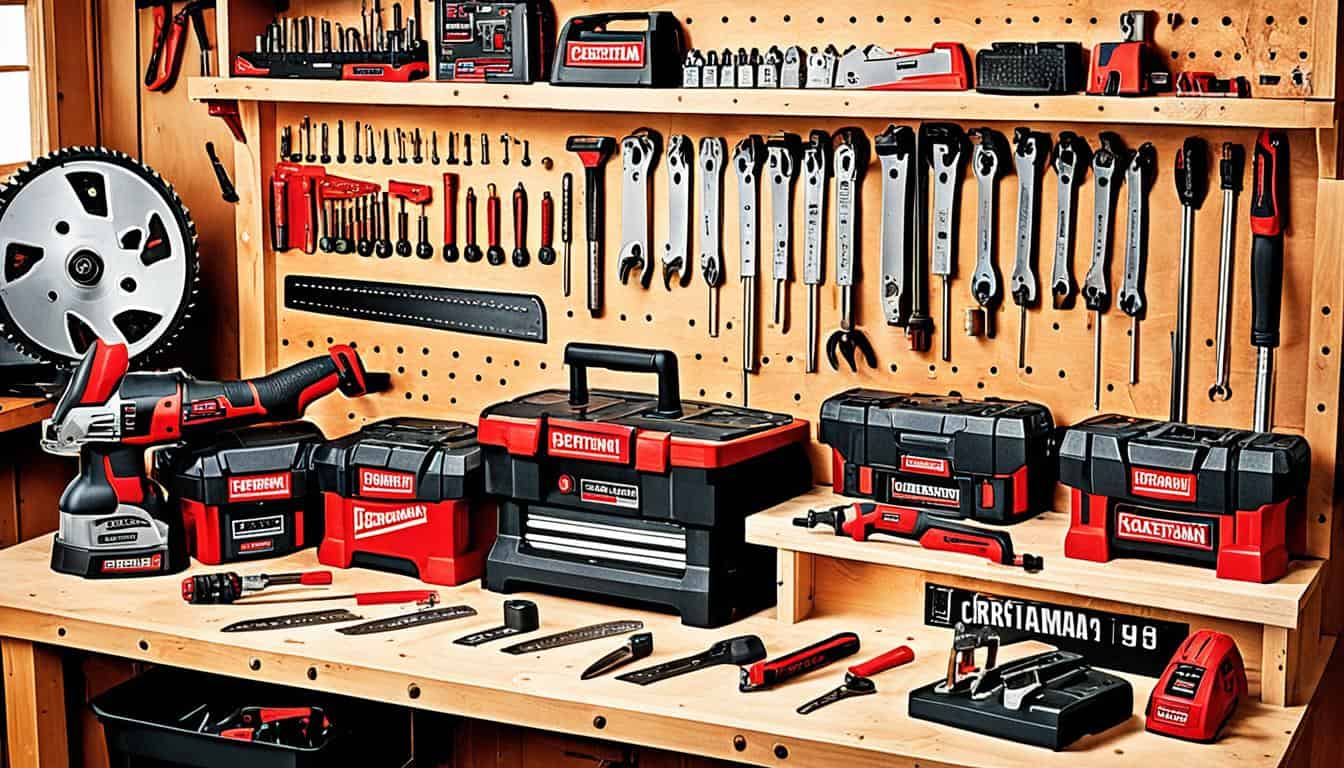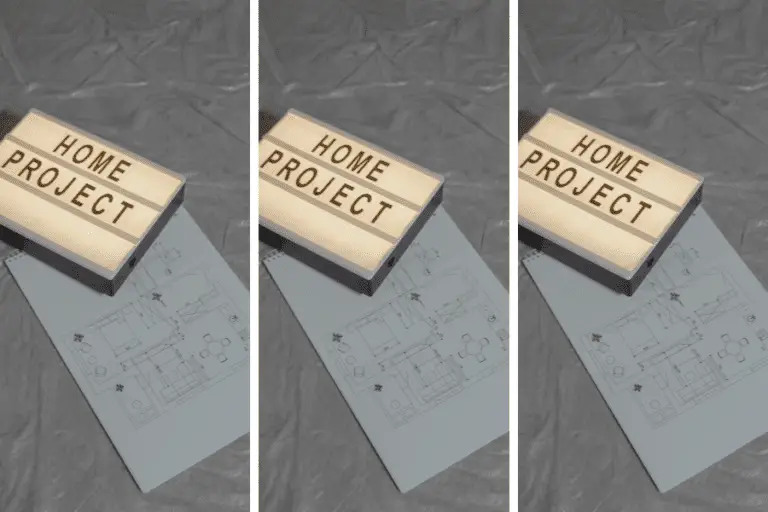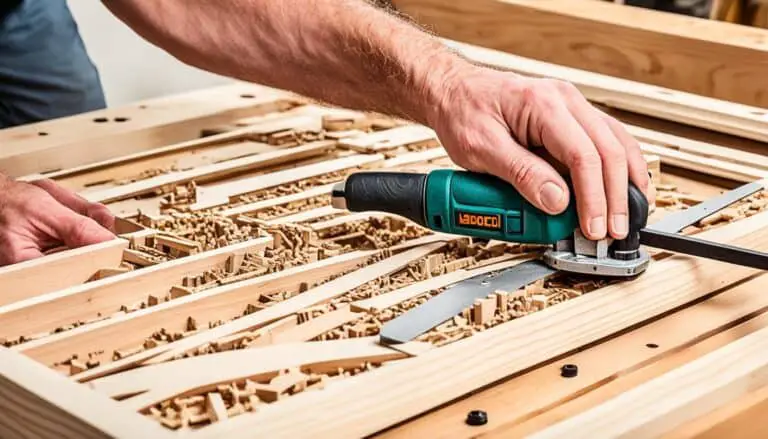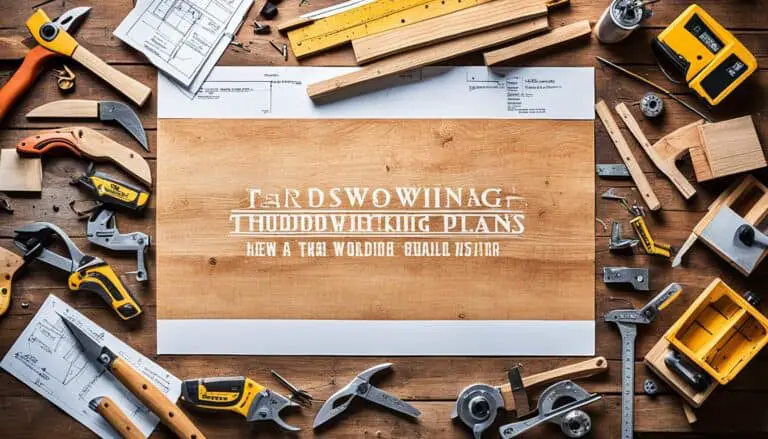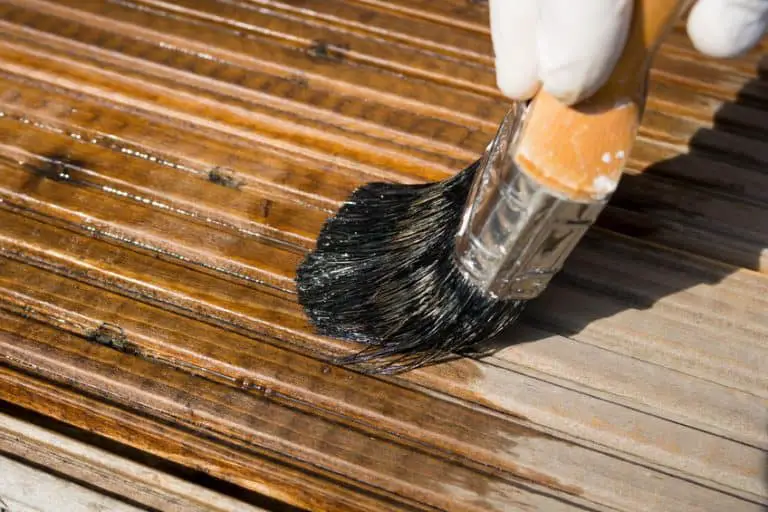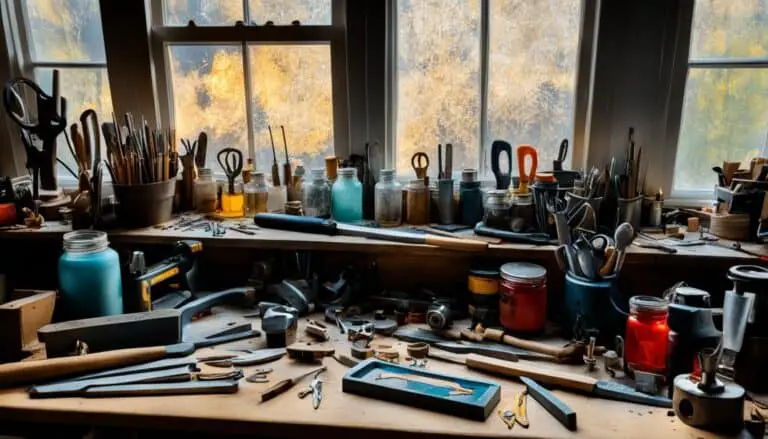Are you a woodworking enthusiast looking to take your crafting skills to the next level? Do you believe that having the right tools can make all the difference in your woodworking projects? If so, you’re in the right place. In this article, we will explore the top woodworking equipment that every skilled crafter should have in their workshop. From power tools to woodworking machinery and accessories, we will dive into the must-have tools that can turn your woodworking dreams into reality.
Key Takeaways:
- Woodworking equipment is essential for skilled crafters to enhance their woodworking skills.
- Having the right tools can make a significant difference in the success and quality of your woodworking projects.
- Power tools, woodworking machinery, and accessories play a crucial role in shaping, joining, and finishing wood.
- Investing in high-quality woodworking equipment is key to achieving successful and enjoyable woodworking projects.
- By having the top woodworking equipment, you can bring your creative visions to life and create beautiful and functional pieces.
Essential Hand Tools: The Soul of the Workshop
Hand tools are the foundation of any woodworking workshop. These essential tools are the soul of the woodworking craft, allowing craftsmen to bring their vision to life with finesse and precision.
Chisels are indispensable tools for shaping and refining wood. They come in various sizes and styles to suit different woodworking tasks. From creating intricate details to carving smooth curves, chisels provide the control and accuracy required for precise woodworking.
Planes are another vital hand tool in a woodworker’s arsenal. They are used for smoothing and flattening surfaces, removing imperfections, and achieving the desired finish. With a well-tuned plane, you can effortlessly shape and refine your wooden creations.
Accurate measurements are crucial in woodworking, and that’s where measuring tools come into play. Measuring tools like marking gauges and squares provide the precision needed for accurate joints. These tools ensure that each piece fits together perfectly, resulting in a sturdy and visually appealing project.
“Hand tools are the core of woodworking, allowing you to connect with the material and shape it with your own hands. They provide a level of control, precision, and connection to the craft that power tools cannot replicate.” – Woodworking Expert
Here’s a table showcasing common hand tools used in woodworking:
| Tool | Description |
|---|---|
| Chisels | Used for shaping and refining wood |
| Planes | Used for smoothing and flattening surfaces |
| Marking Gauges | Used for precise marking and measurement |
| Squares | Used for ensuring accurate right angles |
Investing in high-quality hand tools is a wise choice for woodworkers of all skill levels. These tools not only enable you to create beautiful woodwork but also provide a sense of satisfaction and connection to the craft. With chisels, planes, and measuring tools in hand, you have the essence of woodworking at your fingertips.
Power Tools: The Heartbeat of Modern Woodworking
Power tools revolutionized the woodworking industry, offering craftsmen increased efficiency, precision, and endless possibilities. These incredible machines are the driving force behind the modern woodworking workshop, empowering woodworkers to bring their creative visions to life with ease. Whether you’re a seasoned professional or just starting your woodworking journey, having the right power tools can make all the difference in the quality and efficiency of your projects.
There are several essential power tools that every woodworker should have in their arsenal. These tools include:
- Saws: Power saws, such as circular saws and jigsaws, enable precise and efficient cutting of various materials, including wood.
- Drills: Power drills make drilling holes a breeze, allowing woodworkers to effortlessly create openings for screws, dowels, or other fasteners.
- Routers: Routers are indispensable for woodworking enthusiasts, as they allow for intricate shaping, grooving, and decorative edge treatments.
- Jointers: Jointers ensure the smooth, flat, and accurately squared edges necessary for creating strong, tight-fitting joints.
These power tools act as the heartbeat of modern woodworking, providing the essential capabilities needed to transform raw materials into functional and artistic creations. From making precise cuts to shaping intricate details, power tools offer versatility, precision, and speed, helping woodworkers achieve impeccable craftsmanship and save valuable time in the process.
With the right power tools in your workshop, you can take your woodworking skills to the next level and tackle more ambitious projects. These tools provide the foundation for creativity and innovation, allowing you to push the boundaries of what can be achieved.
Power tools are the driving force behind modern woodworking, offering efficiency, precision, and endless creative possibilities.
The Importance of Safety
While power tools enhance woodworking capabilities, it is crucial to prioritize safety. Always follow manufacturer instructions, wear appropriate protective gear, and practice proper safety procedures when using power tools. Remember to keep your workspace organized and well-maintained to prevent accidents and injuries.
| Power Tool | Main Features |
|---|---|
| Saws | Precise and efficient cutting |
| Drills | Effortless drilling of holes |
| Routers | Intricate shaping and decorative edge treatments |
| Jointers | Smooth and accurate edge preparation |
Tools for Layout
In woodworking, precision is paramount when it comes to achieving accurate joints and angles. The layout phase sets the foundation for a well-crafted project. To ensure precise measurements and markings, you need reliable layout tools. Let’s explore some essential tools that every woodworker should have in their arsenal:
Marking Gauge
A marking gauge is a versatile tool used to mark lines parallel to an edge or at a specific distance from an edge. It consists of a beam and a sharp cutting blade or pin that can be adjusted to the desired measurement. By running the marking gauge along the edge of the workpiece, you can achieve precise and consistent markings.
Marking Knife
A marking knife is a thin, pointed blade used to create accurate and crisp layout lines on wood. It is particularly useful for marking across the grain or when high precision is required. The sharp edge of a marking knife cuts through the wood fibers, leaving a clean and precise line for guidance during the woodworking process.
Combination Square
A combination square is a versatile measuring tool that combines a ruler and a square. It allows you to check and mark 90-degree angles, measure and transfer dimensions, and check the flatness of surfaces. With its adjustable head, a combination square can be locked at various angles, making it ideal for layout work and marking precise angles.
Bevel Gauge
A bevel gauge, also known as an angle gauge, is a tool used to measure and transfer angles. It typically consists of a handle and a blade or protractor head that can be adjusted to match an existing angle or set to a specific angle. A bevel gauge is particularly useful for marking and transferring angles when working on angular or tapered pieces.
By using these layout tools in your woodworking projects, you can ensure accuracy, consistency, and precision in your measurements and markings. Having reliable layout tools in your workshop is essential for achieving professional results.
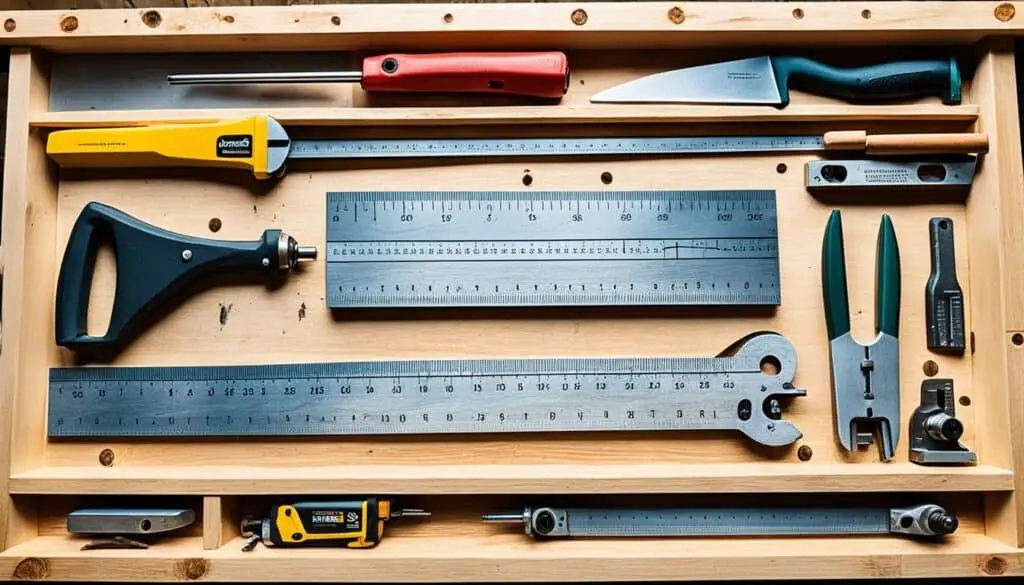
Tools for Joinery
Joinery is a hallmark of woodworking, and the effort to cut joints by hand is well worth it. The right tools are essential for creating tight-fitting joints and achieving precision and craftsmanship in your joinery work.
Dovetail Saw
A dovetail saw is a specialized tool designed for making precise and clean cuts for dovetail joints. Its thin blade and fine teeth allow for intricate and accurate woodworking.
Coping Saw
A coping saw is a versatile tool used for cutting intricate shapes and curves. Its thin blade and adjustable frame make it ideal for precise joinery work.
Chisels
Chisels are indispensable for woodworking joinery. They allow you to carve out and shape the recesses needed for joints such as mortise and tenon or dovetail joints.
Shoulder Plane
A shoulder plane is a specialized plane that is used to clean and square up shoulder cuts, such as those made for tenons. It helps ensure a perfect fit and smooth finish for your joinery.
By using these high-quality joinery tools, such as a dovetail saw, coping saw, chisels, and shoulder plane, you can achieve precise and structurally sound joints in your woodworking projects.
| Joinery Tool | Description |
|---|---|
| Dovetail Saw | A specialized saw for clean and precise cuts in dovetail joints. |
| Coping Saw | A versatile saw for cutting intricate shapes and curves. |
| Chisels | Essential tools for carving and shaping joints. |
| Shoulder Plane | A plane for squaring up shoulder cuts and ensuring a perfect fit. |
Tools for Shaping and Smoothing
Shaping and smoothing tools are vital for achieving a smooth and polished finish in your woodworking projects. They help you refine and perfect the surfaces, creating a professional quality result. Here are some essential shaping and smoothing tools every skilled crafter should have in their arsenal:
Handplanes
Handplanes are versatile tools that can be used for various shaping and smoothing tasks. Block planes and smoothing planes, in particular, are excellent for flattening surfaces and creating crisp chamfers. They allow you to remove imperfections and achieve a smooth, even finish.
Card Scraper
A card scraper is a simple but incredibly effective tool for smoothing surfaces. It consists of a thin, flexible piece of metal that can be sharpened to remove machine marks and tearout. By skimming the card scraper across the wood, you can achieve a polished finish that is free from scratches.
Spokeshave
A spokeshave is an essential tool for shaping and smoothing curved surfaces. It is used to remove wood in a controlled manner, allowing you to shape and refine intricate curves. Whether you are working on a chair leg or a decorative wood element, a spokeshave will help you achieve precise and smooth results.
By incorporating these shaping and smoothing tools into your woodworking process, you can take your craftsmanship to the next level. They provide the necessary precision and refinement to ensure that your projects have a professional finish.
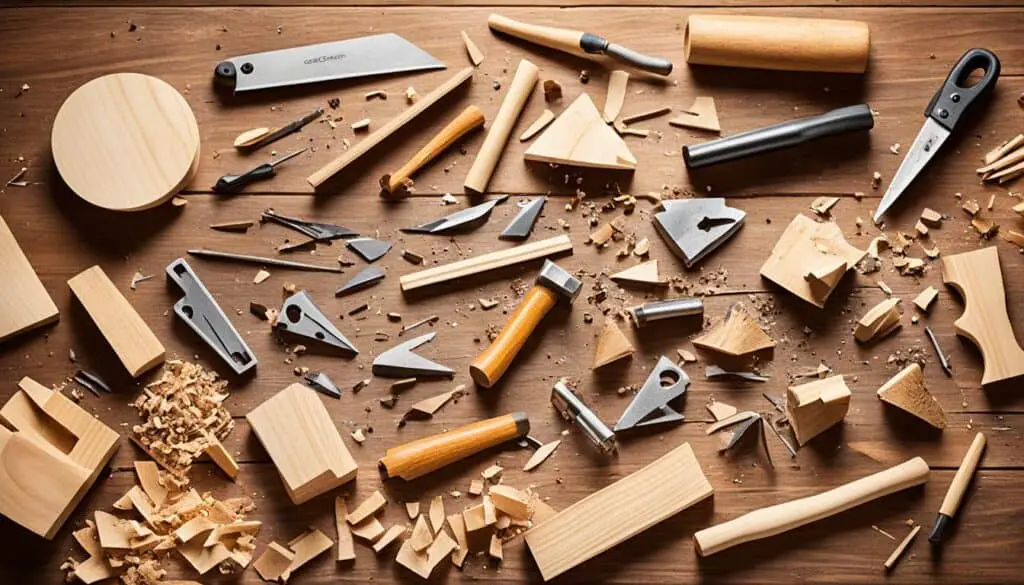
| Tool | Description |
|---|---|
| Handplanes | Used for flattening surfaces and creating chamfers. |
| Card Scraper | Effective in removing machine marks and tearout from wood surfaces. |
| Spokeshave | Perfect for shaping and smoothing curved surfaces. |
Must-Have Tools for Furniture Makers
As a furniture maker, having the right tools is essential to bring your crafting skills to the next level. Whether you’re building a sturdy table, an elegant chair, or a beautifully detailed cabinet, these must-have tools will help you create masterpieces that stand the test of time.
Cutting Tools
One of the first steps in furniture making is cutting the wood to size. Here are the essential cutting tools every furniture maker should have in their arsenal:
- Coping Saw: This versatile tool is perfect for intricate and curved cuts.
- Dovetail Saw: Ideal for precise and clean cuts, especially for joinery work.
Shaping and Smoothing Tools
After cutting, shaping and smoothing the wood is crucial for achieving a polished finish. These tools will help you refine the surfaces and create beautiful curves:
- Smoothing Plane: Use it to level and smooth the wood, leaving a glass-like finish.
- Block Plane: A versatile tool for trimming and chamfering edges.
- Spokeshave: Perfect for shaping concave or convex curves.
Measuring and Marking Tools
Precision is key in furniture making, and these measuring and marking tools will ensure accurate and consistent results:
- Combination Square: A multipurpose tool for measuring angles and checking for squareness.
- Bevel Gauge: Essential for transferring and setting angles accurately.
- Marking Gauge: Use it to create clean and precise lines for cutting and joinery.
- Marking Knife: Ideal for scoring and making accurate layout lines.
Finishing Tools
Finishing touches can make all the difference in furniture making. These tools will help you achieve a flawless and polished look:
- Card Scraper: Great for removing roughness, scratches, and tool marks.
- Shoulder Plane: Perfect for creating precise and flat surfaces for joinery.
- Chisel Set: A versatile set of chisels for carving, trimming, and shaping.
| Tool | Description |
|---|---|
| Coping Saw | A versatile tool for intricate and curved cuts. |
| Smoothing Plane | Used for leveling and smoothing the wood, leaving a glass-like finish. |
| Combination Square | A multipurpose tool for measuring angles and checking for squareness. |
| Marking Knife | Ideal for scoring and making accurate layout lines. |
| Dovetail Saw | Perfect for precise and clean cuts, especially for joinery work. |
| Card Scraper | Great for removing roughness, scratches, and tool marks. |
Importance of Accuracy in Woodworking
In woodworking, precision is paramount. Achieving accuracy in your projects is essential for producing high-quality pieces that are visually appealing and structurally sound. This level of precision can be achieved through the use of measuring and layout tools, which play a crucial role in ensuring precise joints, angles, and dimensions. By utilizing these tools effectively, woodworkers can bring their creative visions to life with accuracy and finesse.
Measuring tools are indispensable in woodworking, providing craftsmen with the ability to obtain precise measurements. Whether it’s measuring the length of a board or checking the squareness of an angle, accurate measurements are essential for achieving tight and seamless joins. Common measuring tools include tape measures, rulers, and calipers, each designed to provide accurate and reliable measurements for woodworking projects.
Layout tools are equally important in woodworking, as they allow craftsmen to mark out precise lines and angles on their workpieces. Marking gauges, marking knives, combination squares, and bevel gauges are just a few examples of layout tools that enable woodworkers to accurately transfer measurements and create consistently aligned joints. These tools ensure that every piece is correctly aligned and serve as the foundation for a well-crafted project.
When working with accuracy in mind, it’s crucial to emphasize the importance of using high-quality measuring and layout tools. Investing in reliable and precise tools will not only enhance the accuracy and efficiency of your woodworking but also contribute to the overall enjoyment of the craft. With accurate measuring and layout tools at your disposal, you can confidently take on woodworking projects, knowing that you have the tools necessary to achieve precise and professional results.
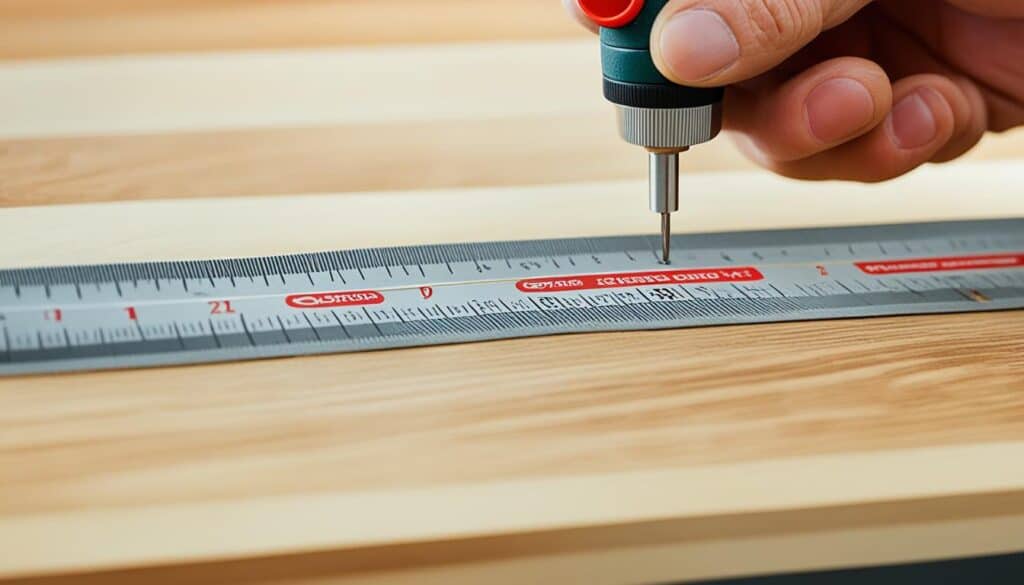
Benefits of Accuracy in Woodworking
Accurate woodworking offers numerous benefits:
- Precision: Accurate measurements and layout ensure precise joints, resulting in aesthetically pleasing and structurally sound projects.
- Professionalism: Achieving accuracy demonstrates a high level of craftsmanship and attention to detail, elevating your woodworking to a professional standard.
- Efficiency: Accurate measurements and layout reduce the need for rework and adjustments, saving time and materials.
- Consistency: By maintaining consistency in your measurements and layout, you can achieve uniformity throughout your project, creating a cohesive and harmonious result.
- Problem-solving: Accurate woodworking requires critical thinking and problem-solving skills, allowing you to tackle complex projects and overcome challenges with precision and confidence.
Achieving accuracy in woodworking may take time and practice, but the investment is well worth it. By mastering the use of measuring and layout tools, you can ensure that each piece you create reflects your craftsmanship and attention to detail. Precision and accuracy are the hallmarks of a skilled woodworker, and by incorporating these principles into your work, you can create beautiful and long-lasting pieces that will stand the test of time.
| Measuring Tools | Layout Tools |
|---|---|
| Tape Measures | Marking Gauges |
| Rulers | Marking Knives |
| Calipers | Combination Squares |
| Bevel Gauges |
Selecting the Right Hand Tools
When it comes to woodworking, selecting the right hand tools is crucial for the success and accuracy of your projects. High-quality and reliable tools are essential for achieving professional results and ensuring a smooth woodworking experience.
Considerations for Selecting Hand Tools
When choosing hand tools for your woodworking arsenal, there are several factors to keep in mind:
- Durability: Look for tools that are made from high-quality materials such as durable metals or hardwood handles. These tools will withstand the rigors of woodworking and last for years to come.
- Precision: Precision is key in woodworking, so opt for hand tools that offer accuracy and precision in their design. Look for tools with finely machined parts and precise measurements.
- Ergonomic Design: Woodworking can be a physically demanding craft, so choosing hand tools with ergonomic designs can greatly improve your comfort and reduce fatigue. Look for tools with comfortable handles and well-balanced weight distribution.
By considering these factors, you can ensure that the hand tools you select will serve you well throughout your woodworking journey.
Essential Woodworking Hand Tools
To get started, there are a few essential hand tools that every woodworker should have in their workshop:
| Tool | Description |
|---|---|
| Chisels | Chisels are versatile tools used for shaping, carving, and removing excess material. Look for a set of chisels with different sizes to accommodate various woodworking tasks. |
| Planes | Planes are used for smoothing and flattening wood surfaces. Invest in a quality hand plane that allows you to adjust the blade for precise shaving. |
| Measuring Tools | Accurate measurements are crucial in woodworking, so having measuring tools like a tape measure, a combination square, and a marking gauge is essential for precise layouts and cuts. |
These tools form the foundation of your woodworking hand tool collection and will help you accomplish various tasks with ease and precision.
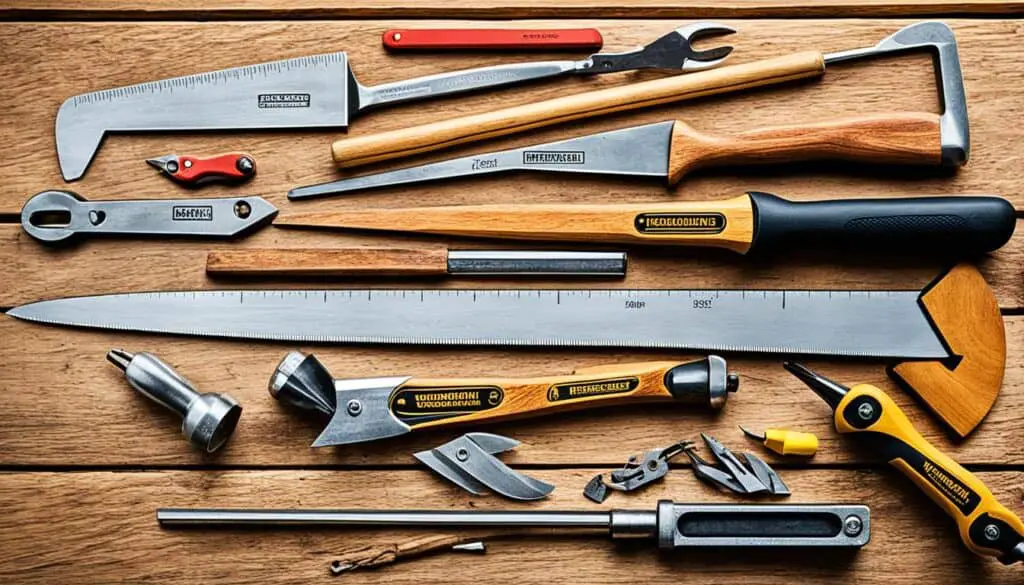
Remember, selecting the right-hand tools is an investment in your woodworking journey. By choosing high-quality, durable, and precise tools, you’ll set yourself up for success and enjoy the art of woodworking to its fullest.
The Role of Power Tools in Woodworking
Power tools play a vital role in modern woodworking, offering a range of benefits that enhance a woodworker’s capabilities and efficiency. Whether you are a seasoned professional or an amateur enthusiast, power tools can revolutionize your woodworking projects. In this section, we will delve into the importance of power tools and how they contribute to the art of woodworking.
Increase Efficiency and Precision
When it comes to power tools, efficiency is key. Power tools such as saws, drills, routers, and jointers enable woodworkers to complete tasks quickly and effortlessly. With the power of these tools, you can cut through materials with ease, drill holes accurately, shape edges precisely, and create smooth finishes. This level of efficiency allows you to complete projects faster, saving you time and effort.
Moreover, power tools provide exceptional precision. They are designed to make consistent and accurate cuts, ensuring that your measurements are exact. This precision is especially beneficial for intricate designs, complex joinery work, and detailed shaping. With power tools, you can achieve the level of precision required to create professional-quality woodworking projects.
Unlock Greater Project Possibilities
With the right power tools, your woodworking potential expands exponentially. The versatility of power tools allows you to take on a wide range of projects, from simple furniture pieces to complex cabinetry and intricate woodworking designs.
Saws, for example, come in various types such as circular saws, band saws, and miter saws. These tools make it possible to cut through different materials, create angled cuts, and achieve intricate shapes. Drills and routers provide the ability to bore holes, route decorative edges, and create intricate details. Jointers facilitate precise and seamless joinery, ensuring strong connections between wood pieces.
In addition to expanding your project possibilities, power tools dramatically enhance your creativity and craftsmanship. They enable you to push boundaries and explore new techniques, allowing your woodworking skills to flourish and evolve.
Improved Safety Measures
Power tools prioritize user safety, integrating various features and mechanisms to prevent accidents and injuries. While it is crucial to follow safety protocols and wear appropriate protective gear, power tools offer built-in safety measures that minimize risks.
For example, most power tools come with safety guards and guides to protect your hands and fingers from accidental contact with blades or bits. They also feature safety switches and lock-off buttons to prevent accidental activation. These safety features, when used correctly, add an extra layer of protection and peace of mind during woodworking tasks.
Enhance Productivity in Your Workshop
Power tools are not only efficient and precise but also boost productivity in your workshop. By reducing manual labor and streamlining tasks, power tools enable you to tackle more significant and complex projects within shorter timeframes.
Moreover, power tools eliminate the physical strain associated with traditional hand tool usage, allowing you to maintain optimal energy levels throughout your woodworking sessions. This increased productivity translates into a higher volume of completed projects and a more efficient use of your woodworking time.
Advantages of Hand Tools vs. Power Tools
When it comes to woodworking, the choice between hand tools and power tools is an important consideration. Both options have their own set of advantages and disadvantages, and understanding these can help you make an informed decision. Let’s explore the pros and cons of each:
Hand Tools
Hand tools are the traditional choice for woodworking, offering precision, control, and a hands-on approach to crafting. Here are some of the advantages of using hand tools:
- Precision: Hand tools allow for meticulous and precise woodworking, allowing you to create intricate details and fine finishes.
- Control: With hand tools, you have complete control over the cutting, shaping, and joining process, enabling you to work at your own pace and adjust as needed.
- Quieter: Hand tools produce less noise compared to power tools, making them a better option for those working in residential areas or shared workshop spaces.
However, hand tools also have some drawbacks:
- Time-consuming: Working with hand tools can be slower compared to power tools, as it requires manual effort and repetitive movements.
- Physical exertion: The use of hand tools can be physically demanding, especially when working on larger projects or using heavy-duty tools.
Power Tools
Power tools revolutionized woodworking by providing efficiency, speed, and the ability to tackle larger-scale projects. Here are the advantages of using power tools:
- Efficiency: Power tools allow you to complete tasks more quickly and efficiently, saving you time and effort.
- Speed: With their motorized operation, power tools can perform cuts and repetitive actions faster than hand tools.
- Versatility: Power tools come in various types and sizes, offering versatility and the ability to handle a wide range of woodworking tasks.
However, power tools also have a few drawbacks:
- Less precision: Power tools may not offer the same level of precision as hand tools, especially when it comes to intricate detailing or delicate finishes.
- Noisier: Power tools generate more noise during operation, which may be a consideration if you’re working in a noise-sensitive environment.
Ultimately, the choice between hand tools and power tools depends on your personal preference, the specific project requirements, and the desired level of craftsmanship. Many woodworkers opt for a combination of both hand tools and power tools to leverage the advantages of each, striking a balance between precision and efficiency.
| Hand Tools | Power Tools |
|---|---|
| Precision | Efficiency |
| Control | Speed |
| Quieter | Versatility |
| Time-consuming | Less precision |
| Physical exertion | Noisier |
Combining the precision of hand tools with the efficiency of power tools can enhance your woodworking experience. By understanding the pros and cons of each, you can make an educated decision and select the right tools for your woodworking projects.
Conclusion
Woodworking equipment is essential for skilled crafters looking to elevate their woodworking skills. Whether you prefer hand tools or power tools, having the right equipment is crucial in shaping, joining, and finishing wood to create beautiful and functional pieces. Investing in high-quality woodworking tools, such as chisels, saws, drills, routers, and planes, ensures the success and enjoyment of your woodworking projects.
Hand tools are the soul of the workshop, providing precision and control for shaping wood with finesse. On the other hand, power tools are the heartbeat of modern woodworking, enabling efficiency and capability in tackling more complex projects. By combining the strengths of both hand tools and power tools, you can achieve the desired level of craftsmanship and bring your creative visions to life.
Remember, accuracy is key in woodworking, so be sure to use measuring and layout tools to ensure precise joints, angles, and dimensions. Whether you’re a seasoned woodworker or just starting out, having the right woodworking equipment in your arsenal will enhance your skills and allow you to create masterful pieces that showcase your talent.
FAQ
What are the top woodworking equipment that every skilled crafter should have in their workshop?
The top woodworking equipment that every skilled crafter should have in their workshop include hand tools, power tools, layout tools, joinery tools, shaping and smoothing tools, and tools for furniture making.
What are the essential hand tools for woodworking?
The essential hand tools for woodworking include chisels, planes, and measuring tools such as marking gauges and squares.
What are the essential power tools for woodworking?
The essential power tools for woodworking include saws, drills, routers, and jointers.
What are the tools for layout in woodworking?
The tools for layout in woodworking include marking gauges, marking knives, combination squares, and bevel gauges.
What are the tools for joinery in woodworking?
The tools for joinery in woodworking include dovetail saws, coping saws, chisels, and shoulder planes.
What are the tools for shaping and smoothing in woodworking?
The tools for shaping and smoothing in woodworking include handplanes, block planes, card scrapers, and spokeshaves.
What are the must-have tools for furniture makers?
The must-have tools for furniture makers include coping saws, smoothing planes, combination squares, bevel gauges, marking knives, dovetail saws, card scrapers, marking gauges, spokeshaves, shoulder planes, block planes, and a set of chisels.
How important is accuracy in woodworking?
Accuracy is crucial in woodworking for precise joints, angles, and dimensions. Measuring and layout tools play a significant role in achieving accuracy in woodworking projects.
How do I select the right hand tools for woodworking?
When selecting hand tools for woodworking, it is important to choose high-quality and reliable options based on durability, precision, and ergonomic design.
What role do power tools play in woodworking?
Power tools play a vital role in modern woodworking, providing efficiency, speed, and the ability to tackle complex projects. They enable woodworkers to achieve intricate designs and improve productivity in their workshops.
What are the advantages of hand tools vs. power tools in woodworking?
Hand tools offer precision, control, and a more traditional approach, while power tools provide efficiency, speed, and the ability to handle larger projects. The choice between hand tools and power tools depends on personal preference, the project at hand, and the desired level of craftsmanship.
Why is investing in high-quality woodworking equipment important?
Investing in high-quality woodworking equipment ensures successful and enjoyable woodworking projects. It allows woodworkers to work with precision, durability, and reliability, enhancing their woodworking experience.


